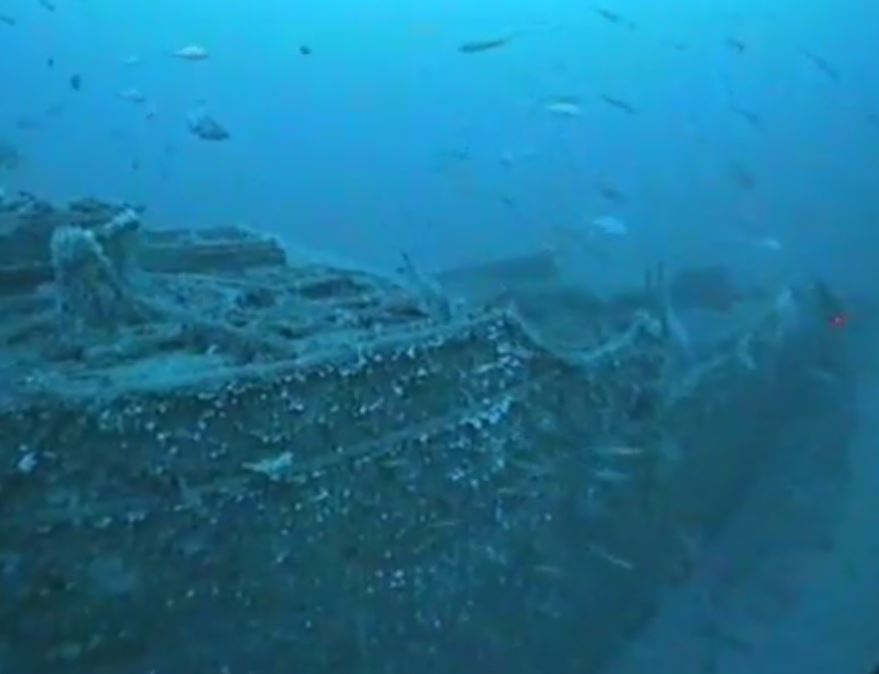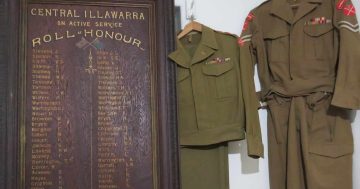
The starboard of the SS Nemesis, discovered about 160 m underwater off Port Kembla. Photo: CSIRO.
For 120 years, the location of the wreck of SS Nemesis and its 32 crew members has been a mystery.
The ship, loaded with coal, left Newcastle on 9 July 1904 headed to Melbourne. It was last sighted in distress in rough seas off Wollongong by another ship also caught in a storm.
Over several weeks, bodies of crew members washed ashore at Cronulla Beach, as well as fragments of the ship’s steering wheel, doors and other floating wreckage.
But the location of the 73 m vessel remained unknown until two years ago, when remote sensing company Subsea Professional Marine Services came across the wreck in waters off Port Kembla, while searching for cargo containers lost off the Sydney coast.
The ship was undisturbed, lying about 26 km offshore and 160 m underwater.
Subsea’s Ed Korber said it was an “absolute honour” to have discovered the wreck and finally bring some closure to the families of its lost crew members.
“Our marine and remote operated vehicle team have navigated difficult challenges to get the first incredible footage that has allowed Heritage NSW to confirm this was indeed the Nemesis wreck,” he said.

CSIRO staff check out underwater camera vision of the Nemesis. Photo: Hugh Barker, CSIRO.
The NSW Government is now hoping to connect with relatives of the crew members, including three men buried in an unmarked grave in Woronora Memorial Park at Sutherland.
About a week after the 1904 disaster, the Daily Telegraph reported that the exact locality of the disaster “cannot be indicated”.
“It is believed that as the gale was driving the seas direct on the coastline, the discovery of the wreckage in a comparatively narrow belt along Cronulla Beach points to the foundering having occurred just off that locality,” the report said.
“Apparently the end was sudden, and possibly unexpected, for there is no evidence to show that the crew made any effort to take to the boats, or to equip themselves with lifebelts or buoys.
“A large number of these were found on the beach, lacking any indication that they had been used, while it does not appear that the boats had been recently manned.”
Environment and Heritage Minister Penny Sharpe said about 40 children lost parents in the tragedy.
“The loss of Nemesis has been described as one of Sydney’s most enduring maritime mysteries and has even been described by shipwreck researchers as the ‘holy grail’,” she said.
“Thanks to collaborative work with CSIRO and Subsea, using modern technology and historical records, Heritage NSW has been able to write the final chapter of SS Nemesis’ story.”

The Nemesis disappeared during a storm in 1904. Photo: CSIRO.
Heritage NSW says members of the lost crew came from Australia, the UK and one from Canada.
Identifying the wreck was a challenge due to its position so far offshore in deep and strong current waters.
Additional underwater imagery captured by the CSIRO confirmed the ship’s distinctive features aligned with historical photographs and sketches of SS Nemesis.
Images show the iron wreck resting upright on a broad sand plain, with significant damage to its bow and stern.
It also revealed a series of clues as to why the ship sank that night. It is thought the engine became overwhelmed in the storm, and when SS Nemesis was hit by a large wave the vessel sank too quickly for lifeboats to be deployed.
Wollongong MP Paul Scully said the discovery of the Nemesis showed why Wollongong continued to explore its history in what is a proud port city.
“This wreck is part of the rich maritime history of the Illawarra which ranges from shipwrecks to the Dalfram dispute, which influenced Australian foreign policy during World War II,” he said.
“With only 105 of the more than 200 shipwrecks off the NSW coast having been discovered, this is an important find.”
Anyone who may have a connection to SS Nemesis is asked to send an email to [email protected].











